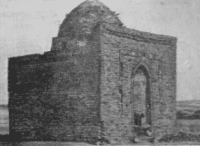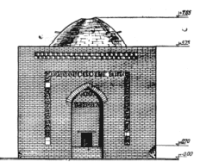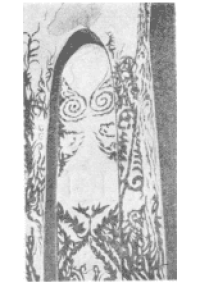You are here
Mausoleum of Tort-Kara. Description G.G. Gerasimov.



Archaeology in Central Kazakhstan.
“One of the characteristic features of the national architecture of Kazakhstan is the use of arches in all sorts of ways. These arches have different outlines: lancet, semicircular, bow-shaped (barrel-shaped); the first and third of them differ from similar arches of other Central Asian monuments in their form and method of construction.
Georgy Gerasimovich Gerasimov.
Architectural monuments of Ulytau.
Tort-Kara mausoleum is located at an altitude of 448 meters above sea level, located 26 meters from right bank of Karatal (Zhetykyz) River, 2.7 kilometers southeast of Khan-Ordasy settlement, 10.8 kilometers northeast of lake Kinembay, 12.2 kilometers east and slightly north of village of Sarlyk, 20.7 kilometers northwest of settlement of Ulytau, in Ulytau district of tregion of same name.
Not far from the district center Ulu-Tau, about 25 kilometers away from it towards Atbasar, on the old caravan route on the postal route from Atbasar to Dzhusaly and to Kyzyl-Orda, there is the Tort-Kara mausoleum.
There are no tomb structures near it, with the exception of one open brick quadrangular fence intended for family burials. It was erected, as they say among the local population, on the grave of one of the representatives of the feudal-tribal elite of local bais in the 50s of the XIX century.
The main entrance of the structure is oriented to the southwest. The steppes of Desht-i-Kipchak stretch all around, famous in their time as the steppes of the “golden plain”. They are crossed in different directions by small spurs of the neighboring Ulutau mountains.
Small rivers and streams flow between the ridges; the wide steppe, rich in greenery in summer, is suitable for cattle breeding. Due to this, the steppes of Desht-i-Kipchak have always been the place of concentration of the most influential representatives of the then feudal-tribal society.
The descendants of Jochi Khan and other khans and sultans once had estates here, and in the 16th century, under Khan Khak-Nazar, even the administrative center of the Kazakh Khanate moved to these places. True, this was influenced, in addition to natural conditions, by the political events that unfolded during this period in Kazakhstan.
The Mausoleum of Tort-Kara is made of burnt red brick of square section (25 x 25 x 5.5 cm) on clay mortar. The work technique is not high, the material used is not of good quality. The volume-compositional and architectural-decorative solution of this building was entirely affected by the previous period of decline in the construction industry and applied art in Kazakhstan.
In the executed architectural details, one can see the imitation of inferior forms and distorted proportions, rooted by this time in local architecture. Its builders failed to creatively accept the best building techniques from the architectural heritage of the past.
Blind imitation of the unartistic forms of modern structures or their direct copying could not, of course, produce an original architectural monument. Many of the details here are primitive. The monument does not even have a clearly defined traditional peshtak.
Instead, a small parapet 1.25 meters high was made above the front wall, which, according to the builders, should have replaced the peshtak. But it is so weak and inexpressive in relation to the volume of the building that it is completely lost on it. On the main façade there is a shallow niche covered with a sluggish lancet arch.
Its proportions are unscaled and inexpressive. The quality of the brickwork is poor. Below, in the depths of the niche, a small trapezoidal entrance opening was made in the form of a window measuring 54 x 77 cm. One can enter the mausoleum only through this opening.
he arch is framed by a shallow U-shaped groove-niche, into which carved ceramic tiles measuring 23 x 23 cm are inserted. Under the arch, on the gabled wall of the niche, there are two horizontally located side by side belts with the same tiles.
The color of the pattern of the tiles is dark red, and the background is a pale greenish, made by staining. Against the general pinkish-red background of the wall, these belts are not particularly noticeable. In order to slightly enliven the monotony of the walls of the facades on the peshtak and side surfaces of the walls, zigzag masonry is displayed under the eaves, which are one of the elements of the architectural design of this structure.
According to the volumetric and compositional solution, this structure will lean towards centric, portal-domed structures with an underdeveloped peshtak, and in terms of planning, to single-chamber buildings. According to the plan, the mausoleum of Tort-Kara resembles Alasha Khan.
According to the external outline, it represents a square - 7.25 - 7.25, and according to the internal outline - 3.92 x 3.94 m. In the nature of interior design, the same traditional techniques are used. Lancet arches only with distorted shapes and proportions cover niches in walls and corners.
Constructive stalactites and lancet arches do not serve their purpose well, they are more decorative than constructive. The masonry of the dome was made in horizontal rows, using the false vault method, so it took an elongated conical shape.
The dome rests on a drum shaped on the outside in the form of an octagonal prism with bevelled edges. On the main axes of this drum, small light openings are left through which meager light penetrates inside. Unlike most mausoleums, the inner surfaces of the walls of Tort-Kara are plastered with clay-adobe mortar and whitewashed with lime.
This somehow softens the shortcomings in the interior. In the niches, a multicolored fresco painting was made on the plaster, depicting a complex Kazakh national ornament. The painting has faded over time in many places, faded and lost the clarity of the drawing.
The floor in the mausoleum is made of brick, laid in a single layer “flat”, there are traces of several burials on it. The shallow foundation of the mausoleum caused uneven precipitation, which in turn led to some distortion of forms.
The general condition of the structure is currently satisfactory, with the exception of minor damage to the corbel of ceramic tiles and the outer corners of the basement.
Geographic coordinates of Tort-Kara mausoleum: N48°46'41 E66°47'32
Authority and photos by:
Georgy Gerasimovich Gerasimov. "Monuments of architecture of the Kara-Kengir river valley in Central Kazakhstan". Publishing house of the Academy of Sciences of the Kazakh SSR. Alma-Ata. 1957







